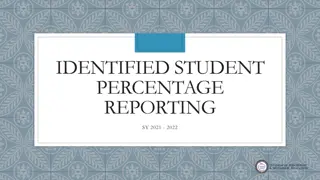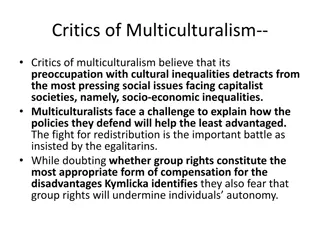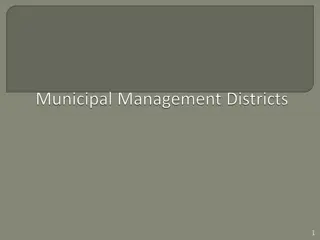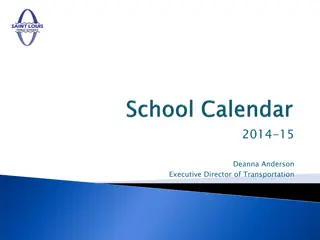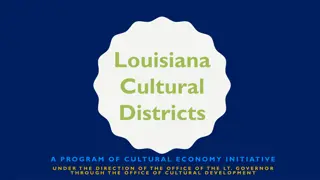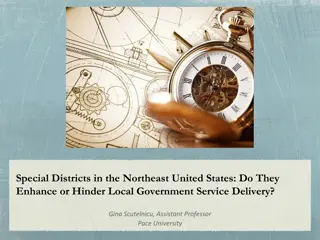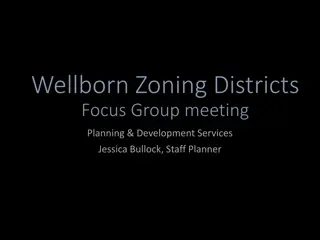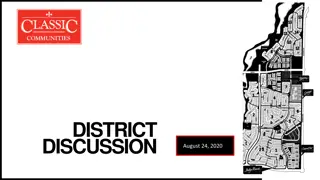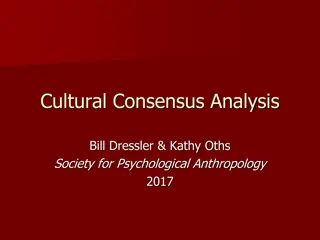
Establishing Cultural Districts in Connecticut: Standards and Criteria Overview
Learn about the legislative statutes, definitions, and key reasons for establishing cultural districts in Connecticut. Discover the process of assessing readiness, meeting standards and criteria, and the benefits of creating vibrant cultural hubs within municipalities.
Download Presentation

Please find below an Image/Link to download the presentation.
The content on the website is provided AS IS for your information and personal use only. It may not be sold, licensed, or shared on other websites without obtaining consent from the author. If you encounter any issues during the download, it is possible that the publisher has removed the file from their server.
You are allowed to download the files provided on this website for personal or commercial use, subject to the condition that they are used lawfully. All files are the property of their respective owners.
The content on the website is provided AS IS for your information and personal use only. It may not be sold, licensed, or shared on other websites without obtaining consent from the author.
E N D
Presentation Transcript
Connecticut Cultural Districts STANDARDS AND CRITERIA OVERVIEW
Cultural Districts Legislative Statute Cultural Districts (Legislative Statute- An Act Concerning the Establishment of Municipal Cultural Districts effective October 2019)
CULTURAL DISTRICT DEFINITION A Cultural District is a specific area of a city or town identified by the municipality that has a number of cultural facilities, activities and/or assets both for profit and nonprofit. It is A walkable, compact area that is easy for visitors to recognize. A center of cultural activities artistic and economic. A place in your city/town where community members congregate, and visitors may enjoy those places that make a community special.
WHY ESTABLISH A CULTURAL DISTRICT? Market Market arts and culture attractions to visitors Promote Promote and encourage artists, entrepreneurs and creative businesses Tourism Promote tourism and increase visitation Quality of Life Improve the quality of life for residents Strengthen Strengthen distinctive character of communities Economic Growth Create a plan to drive economic growth and expand tax base Sustainable CT Support Support Sustainable CT certification https://sustainablect.org/actions-certifications/ Contribute Contribute to Connecticut s cultural assets Highlight Highlight culture and history of your community
ASSESS READINESS Cities and towns should assess their readiness to establish a Cultural District. Assess the inventory and location of cultural assets in the municipality. Submit a letter of intent to establish a Cultural District to your Designated Regional Service Organization (DRSO). Confirm if your city or town is eligible by reviewing the Standards & Criteria.
STANDARDS AND CRITERIA The Cultural District must meet the requirements of Cultural District definition. The municipality must vote to approve Cultural District. The municipality must be in Connecticut. The Cultural District must have defined boundaries. The municipality must hold at least one community input meeting in order for people to learn about the proposed Cultural District and goals. The Cultural District must have cultural facilities and assets. The Cultural District should have public infrastructure and amenities. The Cultural District must be walkable and accessible. The municipality must pass a resolution following the community input meeting/s. The municipality must form a Cultural District Commission. More standards & criteria on next slide.
STANDARDS AND CRITERIA continued Cultural Districts that span more than one town/city, both municipalities must have a supporting resolution Municipalities that have more than one cultural district, one resolution is enough. An inventory of cultural assets must be identified and included on a map.
MAPPING The map should show the boundaries of the proposed Cultural District and where the district is in the municipality (color maps are best). The map should include the following: Cultural facilities Artistic spaces Creative businesses Historic sites Locations of cultural activities
CULTURAL DISTRICT COMMISSION A CITY OR TOWN MUST ESTABLISH A CULTURAL DISTRICT COMMISSION. A CULTURAL DISTRICT COMMISSION MAY BE ESTABLISHED THROUGH ONE OF THE THREE MODELS AND IN ACCORDANCE WITH THE MUNICIPALITY S GOVERNANCE STRUCTURE
CULTURAL DISTRICT COMMISSION 1 2 3 Create new Board/Commission in accordance with local charter requirements. Assign to an existing Board/Commission and create an Advisory Council subcommittee reporting to the existing Board/Commission. Assign Cultural District oversight to an existing Board/Commission, if the Board or Commission can meet the community representation requirement.
Members Cultural District Commission members should include at least one representative from six (6) of the following categories: City, town or borough Local cultural council / arts council Cultural organizations (historical society, museum, ethnic heritage organization) At least one artist that lives and/or works in the district Organizations that represent artists (artist cooperative, etc.) if applicable For-profit creative business i.e. gallery, theater Local business and/or chamber of commerce
Members continued A city, town or borough may elect to include additional representatives. This will depend on the assets in the Cultural District and the district s goals. They can be from: Tourism Historic Preservation/History Leisure Industry (including hotels and similar businesses) Educational Institutions Economic/Community Development
Duties and Procedures THE CULTURAL DISTRICT COMMISSION SHOULD BE RESPONSIBLE FOR DEVELOPING A MANAGEMENT PLAN AND PROVIDE OVERSIGHT WITH IMPLEMENTATION. THE CULTURAL DISTRICT COMMISSION SHOULD CONVENE ON A REGULAR BASIS AND OPERATE IN ACCORDANCE WITH MUNICIPALITY S GOVERNANCE STRUCTURE.
Duties and Procedures continued THE CULTURAL DISTRICT COMMISSION MUST DEVELOP: GOALS AND OBJECTIVES A MANAGEMENT PLAN A CULTURAL ASSETS MAP AND INVENTORY A MARKETING PLAN* GOALS AND SUCCESS MEASURES FOR THE DISTRICT
QUALIFY FOR STATES INVESTMENT OF RESOURCES The Department of Economic and Community Development, including the Office of the Arts and the Office of Tourism, and Designated Regional Service Organizations are committed to supporting the formation, development and establishment of Cultural Districts. All of the above agencies/organizations can provide additional in-kind marketing, promotion and resources for established Cultural Districts.
TYPES OF INVESTMENT IN CULTURAL DISTRICTS: PROMOTION OF CULTURAL DISTRICT BY CT OFFICE OF TOURISM AND RECOGNITION ON STATE S TOURISM WEBSITE, CTVISIT.COM PROMOTION OF CULTURAL DISTRICTS BY CT OFFICE OF THE ARTS PROMOTION OF CULTURAL DISTRICTS BY LOCAL DESIGNATED REGIONAL SERVICE ORGANIZATION (DRSO) SUPPORT FROM DRSO S (I.E., TIME, EXPERTISE, CONSULTING, ETC. AS AVAILABLE OTHER INVESTMENT OPPORTUNITIES AS THEY BECOME AVAILABLE
SUBMIT (ELECTRONICALLY) THE FOLLOWING DOCUMENTS TO CT OFFICE OF THE ARTS FOR REVIEW: LETTER OF ENDORSEMENT FROM CHIEF ELECTED OFFICIAL COPY OF RESOLUTION FROM THE CITY COUNCIL/BOARD OF SELECTMEN (SEE SAMPLE RESOLUTION) MASTER MAP: PLEASE PROVIDE A MAP OF THE CULTURAL DISTRICT LIST OF CULTURAL ASSETS, INCLUDING CULTURAL EVENTS HELD AT LOCATIONS WITHIN THE PROPOSED CULTURAL DISTRICT LIST OF AVAILABLE MUNICIPAL RESOURCES THAT WOULD SUPPORT AND/OR BENEFIT CULTURAL DISTRICT (EX. TAX CREDIT, INCENTIVES, ETC.) OFFICIAL LEGAL DOCUMENTS ON ZONING OVERLAPS OR ORDINANCES RELEVANT TO THE CULTURAL DISTRICT, SUCH AS EXISTING ARTS OR HISTORIC DISTRICT (IF APPLICABLE) MARKETING MATERIALS, IF RELEVANT TO THE CULTURAL DISTRICT To qualify for State s investment of resources
SITE VISIT A MEETING WITH THE CHIEF ELECTED OFFICIAL AND/OR DESIGNEE AND/OR OTHER RELEVANT MUNICIPAL EMPLOYEES A WALKING TOUR OF THE PROPOSED CULTURAL DISTRICT A MEETING WITH THE CULTURAL DISTRICT COMMISSION/COMMITTEE MEMBERS AND APPROPRIATE STAKEHOLDERS TO HEAR ABOUT THE GOALS, OBJECTIVES AND PLANS FOR THE CULTURAL DISTRICT
ADDITIONAL RESOURCES Sustainable CT Alignment (In progress) Municipalities participating in Sustainable CT may be able to meet the criteria and received points for Action Item 3, Vibrant and Creative Cultural Ecosystems, through the Cultural District designation. Sustainable CT municipal participants are eligible to apply for Community Matching Funds. Community Matching Funds provide one-to-one matching funds for projects that align with Sustainable CT actions and Community Match Fund projects helps towns earn points towards certification.
ADDITIONAL RESOURCES At present, the statute that established the legislation does not include grant funds. A variety of funding opportunities are available through the Connecticut Office of the Arts, the State Historic Preservation Office, Sustainable CT, and Connecticut Humanities. CT Office of the Arts State Historic Preservation Office Connecticut Humanities CT Tourism Districts


